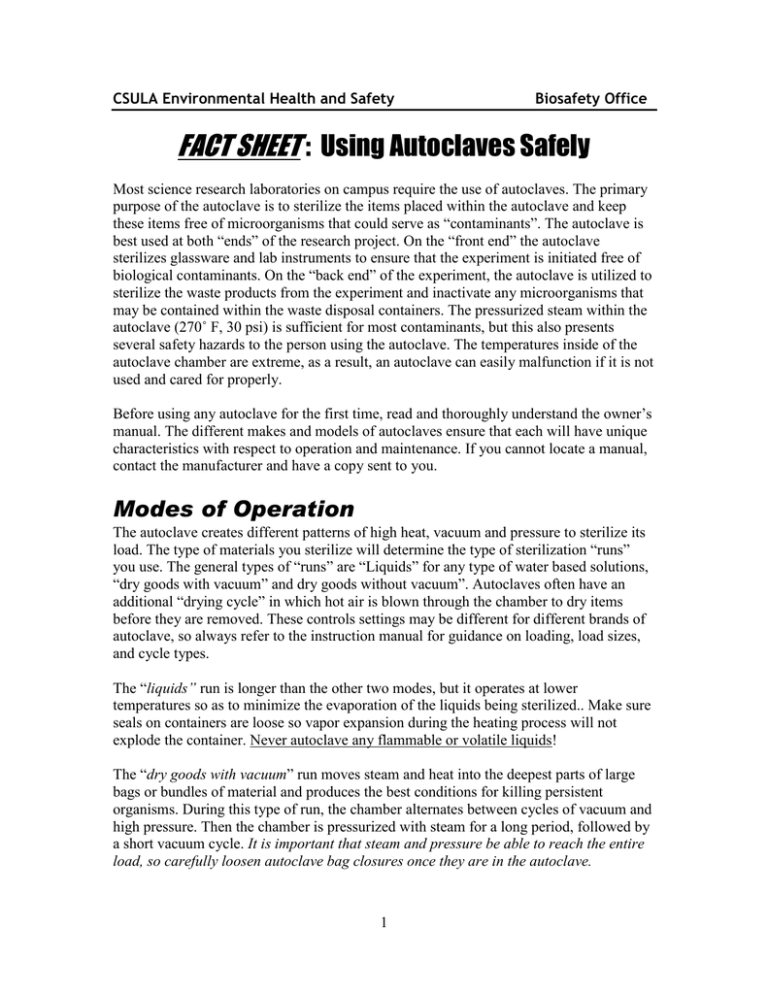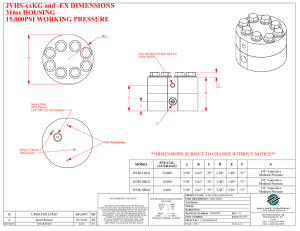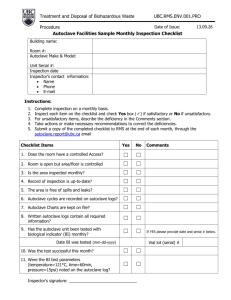FACT SHEET : Using Autoclaves Safely
advertisement

CSULA Environmental Health and Safety Biosafety Office FACT SHEET : Using Autoclaves Safely Most science research laboratories on campus require the use of autoclaves. The primary purpose of the autoclave is to sterilize the items placed within the autoclave and keep these items free of microorganisms that could serve as “contaminants”. The autoclave is best used at both “ends” of the research project. On the “front end” the autoclave sterilizes glassware and lab instruments to ensure that the experiment is initiated free of biological contaminants. On the “back end” of the experiment, the autoclave is utilized to sterilize the waste products from the experiment and inactivate any microorganisms that may be contained within the waste disposal containers. The pressurized steam within the autoclave (270˚ F, 30 psi) is sufficient for most contaminants, but this also presents several safety hazards to the person using the autoclave. The temperatures inside of the autoclave chamber are extreme, as a result, an autoclave can easily malfunction if it is not used and cared for properly. Before using any autoclave for the first time, read and thoroughly understand the owner’s manual. The different makes and models of autoclaves ensure that each will have unique characteristics with respect to operation and maintenance. If you cannot locate a manual, contact the manufacturer and have a copy sent to you. Modes of Operation The autoclave creates different patterns of high heat, vacuum and pressure to sterilize its load. The type of materials you sterilize will determine the type of sterilization “runs” you use. The general types of “runs” are “Liquids” for any type of water based solutions, “dry goods with vacuum” and dry goods without vacuum”. Autoclaves often have an additional “drying cycle” in which hot air is blown through the chamber to dry items before they are removed. These controls settings may be different for different brands of autoclave, so always refer to the instruction manual for guidance on loading, load sizes, and cycle types. The “liquids” run is longer than the other two modes, but it operates at lower temperatures so as to minimize the evaporation of the liquids being sterilized.. Make sure seals on containers are loose so vapor expansion during the heating process will not explode the container. Never autoclave any flammable or volatile liquids! The “dry goods with vacuum” run moves steam and heat into the deepest parts of large bags or bundles of material and produces the best conditions for killing persistent organisms. During this type of run, the chamber alternates between cycles of vacuum and high pressure. Then the chamber is pressurized with steam for a long period, followed by a short vacuum cycle. It is important that steam and pressure be able to reach the entire load, so carefully loosen autoclave bag closures once they are in the autoclave. 1 The “dry goods without vacuum” run simply pressurizes the chamber with steam for the duration of the cycle, and then returns to normal. This process is used primarily for items that have been cleaned, but need to be sterilized. Materials should be packed so that the heat and pressure can readily reach the whole load. Ensuring Complete Sterilization It is imperative to know that the autoclave has thoroughly sterilized its contents. Most autoclave bags or tapes are imprinted with a dye that changes color when the correct temperature has been reached. The problem with this check is that the dye is on the surface of the load and a positive reading does not ensure that the innermost parts of a large load are also sterile. However, an easy way to check this is to wrap something with autoclave tape (a disposable plastic tube or pipette tip are possibilities), and attach string to it as it is being inserted deep into the interior of the load to be autoclaved. Tape the other end of the string to the outside of the bag so that you can easily pull the indicator out. (NOTE: Do not open up a load of potentially infected material to bury something inside). Recover the indicator after the run and confirm that it too has changed color. Routine Maintenance It is a good practice to use a Biological Indicator (e.g., Amsco’s Proof System, BBK’s Kilit), monthly to confirm that the autoclave is working properly. If either the dye or biological indicator fails, the autoclave must be examined to identify and correct the problem and also re-autoclave the load to ensure sterility. Labs will be notified anytime an autoclave fails to pass tests with Biological Indicators. The best way to ensure your autoclave is working properly is to have regular maintenance performed. The regularity of this maintenance is usually determined by the age of the unit, the type of water supply (filtered water, unfiltered/unsoftened water or steam-fed) and frequency of use. Autoclaves that are water fed systems with hard water sources require more frequent maintenance and inspection to ensure that the water softeners, or water filtration systems are tended to appropriately so as to ensure the minimum of buildup on the units heating elements. Excessive build-up on the heating elements force the excessive use of energy, created additional expense due to frequent failure of heating elements, and may result in un-sterilized loads. In addition, users should perform the daily and weekly maintenance procedures described in the owner’s manual. Also make sure that any drain strainers are clean before each run. Autoclave Safety Autoclaves generate extreme heat and high pressure. All users should understand and respect the hazards these conditions create. Autoclave doors and their gaskets must be firmly locked into place before running the autoclave. To prevent a sudden release of high pressure steam most, but not all, autoclaves have safety interlocks that will prevent the unit from running if the doors are not securely closed. You should check your autoclave for interlocks and use extra caution if there are no interlocks present. 2 Some older autoclaves have little or no heat shielding around the outside. At times, some autoclaves that do have this shielding may have the shielding removed from the unit. Please be aware of the potential to sustain severe burns if you touch any of the hot elements of the autoclave. Interior components may be especially hot, so extra caution should be exercised around any autoclave with its interior components exposed or unshielded. Do not stack or store combustible material next to an autoclave (cardboard, plastic, volatile or flammable liquids). Always use heat resistant gloves when removing materials after sterilization and avoid touching the inner chamber surfaces. If you are burned while using the autoclave, you can go to the Campus medical Clinic and receive treatment. Any burn to the face or covering extensive areas of the body should be treated as an emergency. Call 911 from any campus phone to reach emergency operators. Very minor burns may be treated your self using standard first aid. Regardless of the degree of severity, report ALL burns to your supervisor or Principal Investigator as an injury. Acceptable Materials Obviously, the extreme conditions created by the use of high heat and pressure inside of the autoclave will require careful consideration of the type of material that goes into the autoclave. Information below should be considered as general information on this subject. For additional information with respect to suitability for autoclaving, consult with your laboratory supervisor, Principal Investigator, or refer to manufacturer’s technical services department. Glass: In general, the only glass you should place inside the autoclave is Pyrex or Pyrex type material. Most vendor guides will indicate if a particular brand of glassware may be autoclaved. However, even Pyrex type glassware will explode if it contains a sufficient volume of liquid and the container is securely closed. Never autoclave liquids in a closed container. Polypropylene: Polypropylene is an inexpensive resin, which can withstand autoclaving temperatures. Polypropylene containers are available in a variety of shapes and forms including bags, pans and trays. The bags must be open to allow steam to penetrate. It is advisable to pour a small amount of water into the bag prior to autoclaving to facilitate heat transfer to items being sterilized. Latex or Vinyl: These items will generally melt inside of an autoclave. Combustion is possible. However as waste items, placed inside of an autoclavable biohazards bag and with a steam setting, these items will melt slightly, but will not combust resulting in fire or smoke. Since biohazard bags inside of an autoclave often contain latex or vinyl safety gloves as well as paper and plastic culture plates, some melting should be observed with respect to these items. As paper is also frequently present always use a “wet” (steam producing) setting for autoclaving all bags of waste. Failure to do so has resulted in fires! 3 Paper: Paper should not be placed inside of an autoclave except as a waste item inside of a red or clear biohazardous autoclave waste bag. Never sterilize waste containing paper on a “dry” setting. Always use “wet” (steam producing) settings to prevent a fire. Plastic pipette tips and culture plates: Some of these tips are plastic, some are high density polyethylene. The degree to which melting will occur will depend upon the setting of the autoclave, density of the material, and the type of plastic. In general, pipette tips should only enter the autoclave as waste inside of an approved biohazards bag and always sterilized on a steam producing setting. Metals: Most metals used in laboratories are designed for extreme conditions and are intended to be sterilized. With few exceptions metal objects may be autoclaved. Even small cages used in housing animals may be autoclaved, just be sure to remove any plastics, liners or other items that may melt or combust. Plant Material: Plant material, especially transgenic plant material must be inside of a red or clear biohazard bag, with a cup (or more) of water added and with the bag unsealed. Unacceptable Materials It should go without saying, but every year campuses have fires or situations of excessive smoke production in an autoclave because someone forgot to be mindful of what was being placed inside the autoclave. There are a few items that under no circumstance should EVER be placed inside of an autoclave. These items include: * Radioactive material or any material that may be contaminated by radiation. * Combustible, flammable or volatile liquids. * Any liquid in a sealed container. * Any material contained in such a manner that it touches the interior surfaces of the autoclave. Steam Autoclave Sterilization Reference Table General Category Regular Trash Glassware Liquids Animals. Tissue Animal Bedding Sterilization Parameters 250 F (121 C) for 1 hour with 15 minutes prevacuum of 27 inches Hg. 250 F (121 C) for 1 hour with 15 minutes prevacuum of 27 inches Hg (for filled NIH Glassware can) 250 F (121 C) for 1 hour for each gallon Not Permitted on this campus. 250 F (121 C) for 8 hours with 15 minutes prevacuum of 27 inches Hg 4 In order to establish autoclaving time guidelines, a number of loads of waste material were autoclaved using a variety of conditions. The following autoclaving times are suggested: Waste Profile Low-sided polypropylene pan/basin w/ waste bag ½ full, loosely sealed Low-sided polypropylene pan.basin w/ waste bag ½ full, tightly sealed 6 and 12 gallon polypropylene containers w/out lids, bag open, ½ full Metal pails w/ bags loosely gathered, ½ full, no lid on pail Metal pails w/ waste bags with lid on pail Sterilization Time Required 30 minutes 60 minutes (+) 90 minutes (+) 30 minutes 45 minutes Please note that these results are NOT definitive. They are included to give an indication of realistic times which are necessary to sterilize waste products. Effective Sterilization of Biohazard Wastes Correct Method of Packaging: The correct packaging of waste ensures that steam penetrates the load. It is important to remember that the density of the load affects steam penetration; bags packed to capacity with biohazardous waste will not be properly sterilized even if all autoclave operating parameters are observed. Therefore, if autoclave bags are not overloaded or the waste too compacted inside the waste should be properly sterilized. The waste should be placed inside of red or clear polypropylene autoclave bags with time tape affixed to the bag. Waste bags should be opened at the ends prior to initiation of sterilization. Polypropylene is impervious to steam, if the autoclave bags is left closed during sterilization, the inner temperature of the bag will not be sufficient for decontamination. Bags should rest on trays inside of the autoclave. Polypropylene resin trays are recommended. The tray will capture spills in the events liquids escape from the bag. Serological pipettes (long, plastic) may be autoclaved in large five (5) gallon sharps containers provided by the Biosafety office. ALL OTHER SHARPS AND SHARPS CONTAINERS ARE NOT AUTOCLAVED AT CSULA. Serological pipettes may also be autoclaved in reusable, autoclavable trays also provided by the Biosafety Office. Properly Loading the Unit: To effectively sterilize biohazardous wastes, it is important to properly load the autoclave. Adding one cup of water to solid wastes creates additional steam that drives residual air from the bag. It is also important to allow the steam to circulate freely throughout the chamber. Do not overload the chamber with bags that are too large for the capacity of the autoclave chamber. Always place autoclave bags on a tray or in a basin. Failure to do so may result in a bag melting through the autoclave rack and adhering to the chamber interior. The use of a tray or basin also ensures that odors are minimized by keeping media and culture solutions contained inside the basin or bag 5 and not ripping into contact with the chamber where sugars in the solution caramelize and scorch on the chamber’s interior surfaces. While clean and contaminated items may be sterilized in the same autoclave, do not mix them together during the same cycle – they require different exposure times. NEVER place “sharps” (needles, broken glass, etc.) in a biohazard bag. All sharps must be disposed of in sharps containers which in turn are shipped for incineration. Using Approved and Properly Operating Autoclaves: The ability of autoclaves to sterilize biohazardous waste is determined through periodic testing. These tests determine the time, pressure and temperature needed to safely decontaminate waste in each autoclave through the use of a biological indicator which uses spores of Bacillus stearothermophilus, which is rendered unviable at 250 F (121 C). For this test, ampoules of B. stearothermophilus are autoclaved along with a load of waste. Upon completion of the cycle, the ampoules are incubated for 48 hours and then observed for any sign of growth which would indicate that the autoclave is not sterilizing properly. If growth occurs, the autoclaves are retested until a cycle time that allows for decontamination is found. The results are posted on nearby autoclave operating signs. Always make an entry into the “Autoclave Use Log” when utilizing the autoclave. Information on this log is useful in determining proper maintenance schedules and in planning on future needs for autoclave facilities. Any questions about this procedure should be directed to the Biosafety Office at: 3-6359. Unloading the Autoclave: When the cycle is complete, wait until the chamber pressure gauge reads ”zero” before attempting to open the autoclave. A waiting period of several minutes is required before removing the bag from the autoclave. This will allow the chamber and any residual liquids to cool, significantly reducing your chances of getting burned. Also be aware of molten agar that may have seeped from the bag and collected in the pan or tray during the cycle. Use special caution when autoclaving containers that may have become pressurized. Never autoclave a sealed container of liquids as this may result in an explosion of super heated liquid during the cycle or when the container is opened. Always wear heat protective gloves when removing waste from the autoclave! Packaging and Disposing of Sterilized Waste: After you have removed the waste from the autoclave, inspect the “autoclave tape” that was affixed to the bag prior to placement of the waste inside of the autoclave. The word “AUTOCLAVED” should appear clearly on the tape. This indicates to inspectors and workers at waste handling facilities that the bag they are handling has been sterilized. If you forgot to add tape to the bag or if the tape failed to change, you must repeat the process again. Next, place the autoclaved bag inside of a strong, dark colored trash bag. Seal the bag securely and immediately dispose of into the building’s dumpster. Do not let sterilized waste remain inside of the autoclave room. Custodial staff does not have responsibility for this waste stream. The lab that generated this waste is responsible for ensuring that it is placed into the building’s dumpster. 6 Causes of Autoclave Failure The reasons for autoclave failure (sterilization failure) usually fall into two categories – failure of the operator or mechanical failure due to breakdown or improper maintenance. Mistakes made by the operator include: * Improper use of containers that block access of steam to the load * Sealing the bag closed before autoclaving. * Failure to add water to a dry load before autoclaving * Autoclaving a bag that is too large for the autoclave * Over-filling an autoclave bag * Insufficient time settings Mechanical failures need to be addressed by an individual trained in the maintenance and repair of the autoclave. Contact the appropriate department or Building Facilities Coordinator to ensure prompt response to any malfunction of the autoclaves. If you notice repeated failures of autoclave tape to properly indicate that the waste load was sterilized please contact the Biosafety Office at: 3-6359 For more information on biohazard decontamination, sterilization techniques, or containment of biohazards please contact the EH&S Biosafety Office at: 3-6359 7





